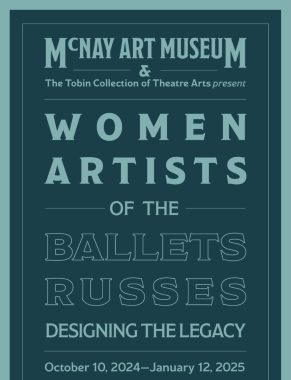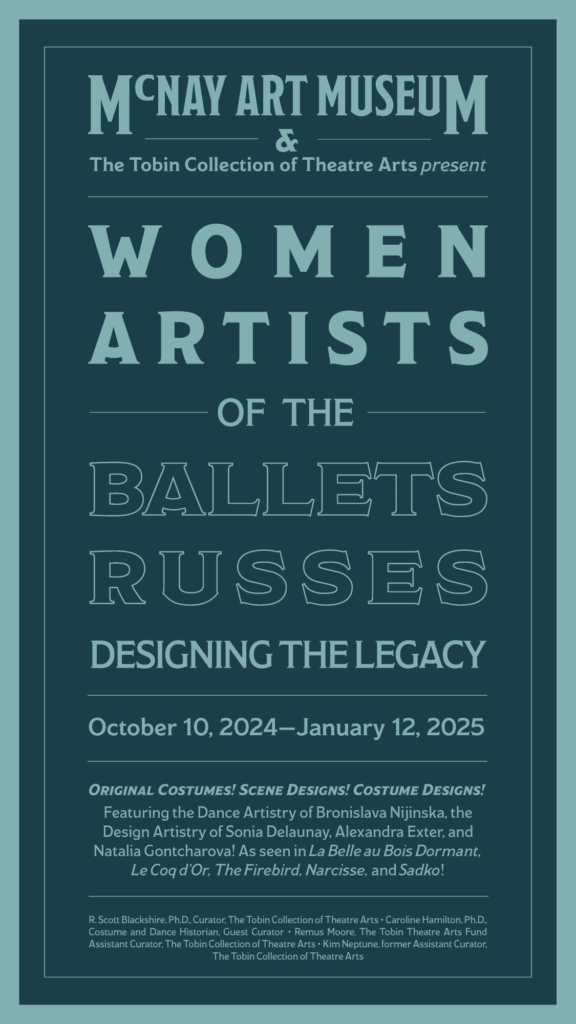WHO WERE THE WOMEN OF BALLET RUSSES?
The McNay Art Museum in San Antonio, TX is turning to its esteemed Tobin Collection of Theatre Arts to re-contextualize Diaghilev’s Ballets Russes in Women Artists of the Ballets Russes: Designing the Legacy, on view Oct. 10, 2024-Jan. 12, 2025. I discovered the McNay last year, and it’s definitely worth the trip if you’re coming from Austin or other environs. Aside from the gorgeous surroundings and a most impressive display of art, McNay’s Tobin Collection of Theatre Arts knocked me out. The late philanthropist Robert L.B. Tobin was devoted to the celebration of visual arts in the theatre; his namesake collection represents more than 500 years of excellence in theatre arts with over 10,000 paintings, works on paper, maquettes and sculpture and 2,000 rare books of European and American theatre design from 1600 to the present. The models of sets on display was the highlight of my visit.
McNay Art Museum Courtyard (Siggi Ragnar Photography)
Built in the 1920s by artist and educator Marion Koogler McNay, the Spanish Colonial Revival residence became the site of Texas’s first modern art museum when it opened in1954. Today, 200,000 visitors a year enjoy works by modern masters including Paul Gauguin, Vincent van Gogh, Edward Hopper, Joan Mitchell, Alice Neel, Georgia O’Keeffe, Pablo Picasso, Jackson Pollock and Pierre-Auguste Renoir. The 25 acres of beautifully landscaped grounds include sculptures by Willie Cole, Robert Indiana, Luis A. Jiménez Jr., Alejandro MartÃn, George Rickey, Joel Shapiro, Kiki Smith, Tom Wesselmann and others. The McNay is open Wednesday and Friday from 10 a.m. to 6 p.m.; Thursday from 10 a.m. to 9 p.m.; Saturday from 10 a.m. to 5 p.m.; and Sunday from Noon to 5 p.m.
For Women Artists of the Ballets Russes, original costumes, set and costume designs and archival photographs chronicle the dance company’s history and shine the spotlight on the often-overlooked creative contributions and legacies of artists Natalia Gontcharova, Sonia Delaunay and Alexandra Exter and dancer and choreographer Bronislava Nijinska.
“While the genesis and impact of Ballets Russes (1909-1929) is well known, the incredible women who worked with this company on and off stage have often been overlooked,” said Caroline Hamilton, Ph.D., Ballets Russes costume and dance historian and exhibition co-curator. “This exhibition aims to celebrate and give voice to these female artists including designers, dancers, costume makers and financial patrons who worked with the Ballets Russes and contributed to its legacy.”
The McNay pairs its holdings with costumes, designs and ephemera on loan from other institutions, offering deeper insight into the objects on view and the women artists who created them. The exhibition also reunites several designs with their realized costume and set pieces for the first time in nearly a century.
Natalia Gontcharova, City of Shemakha in Le Coq d'Or (The Golden Cockerel),ca. 1922. Oil on canvas. Collection of the McNay Art Museum, Gift of Robert L.B.Tobin, TL1998.168. © Artists Rights Society (ARS), New York/ADAGP, Paris
Natalia Gontcharova accepted an invitation from Serge Diaghilev, founder of Ballets Russes, to design sets and costumes for the 1914 opera-ballet Le Coq d’Or (The Golden Cockerel). Gontcharova, known for her vibrant and floral designs, combined elements of Russian folk art and contemporary painting with her sense of humor to create spirited designs that cemented her artistic relationship with ballet through the 1950s. The exhibition includes a bold curtain design for the prologue of “Le Coq d’Or” that reflects cultural references from her early life in Russia as well as an original set piece from the 1937 revival.
Natalia Gontcharova, Curtain design for the prologue in Le Coq d'Or, 1913. Watercolor and collage on paper. Collection of the McNay Art Museum, Gift of The Tobin Theatre Arts Fund, TL2008.9. © Artists Rights Society (ARS), New York/ADAGP, Paris
Gontcharova’s floral motifs and elements of her stage designs are also evident in the frontispiece for the 1921 volume Russian Ballet in Western Europe. While living in Madrid, Sonia and Robert Delaunay met Diaghilev, who invited them to design costumes and set designs for Ballets Russes’ 1918 production of Cléopâtre after the original 1909 sets and costumes designed by Léon Bakst were partially destroyed by fire. Sonia designed the costumes and introduced bold colors and geometric designs that were also evident in her later stage work and fashion designs, a hallmark of her celebrated simultanéisme technique that juxtaposed contrasting hues and shapes to create movement and rhythm.
Natalia Gontcharova, Design for frontispiece of The Russian Ballet in Western Europe, 1909-1920, ca.1921. Ink, watercolor, and graphite on paper. Collection of the McNay Art Museum, Gift of Robert L. B. Tobin, TL1998.235. © Artists Rights Society (ARS), New York/ ADAGP, Paris
Alexandra Exter had collaborated with Nijinska from the late 1910s, and although she never worked for the Ballets Russes, in 1925 she created the designs for six new ballets for the U.K.tour of the Théâtre Chorégraphique Nijinska. This included the ballet Holy Etudes, which brought a modernist and constructivist vision to the stage. Exter garnered international acclaim for her set and costume designs and taught stage design and worked in performing arts in France, Italy and England.
Alexandra Exter, Scene design for Holy Etudes, 1925. Gouache and metallic paint on paper. Collection of the McNay Art Museum, Gift of The Tobin Endowment, TL2001.64.
Bronislava Nijinska’s contributions to ballet spanned more than 60 years. She joined the Ballets Russe sin 1909 as a dancer with her brother Vaslav Nijinksy, the company’s most celebrated member. Though lesser known than Nijinsky, Nijinska’s creativity had a longer-lasting impact on the dance company, where, from the 1920s, she both choreographed and danced starring roles. Women of the Ballets Russes: Designing the Legacy highlights Nijinska’s choreographic storytelling through stunning ballets like Les Noces, Le Train Bleu, Les Biches and Le Renard as well as her additions to The Sleeping Princess.
Nijinska settled in the United States in the late 1930s and would be instrumental in training the first wave of American born ballet dancers. The McNay’s exhibition focuses on the legacy that the famed dance company and these women had on ballet in the U.S., highlighting dancers of color who found historic opportunities with the companies that emerged in the wake of the Ballets Russes. Personal ephemera mark their historic accomplishments in light of the contemporary issues of representation on stage.Among these women are ballerinas Sono Osato and Raven Wilkinson, the first Asian-American and the first African-American to dance with a major company respectively, and Maria Tallchief who was taught by Nijinska and would become the first Native American prima ballerina.


